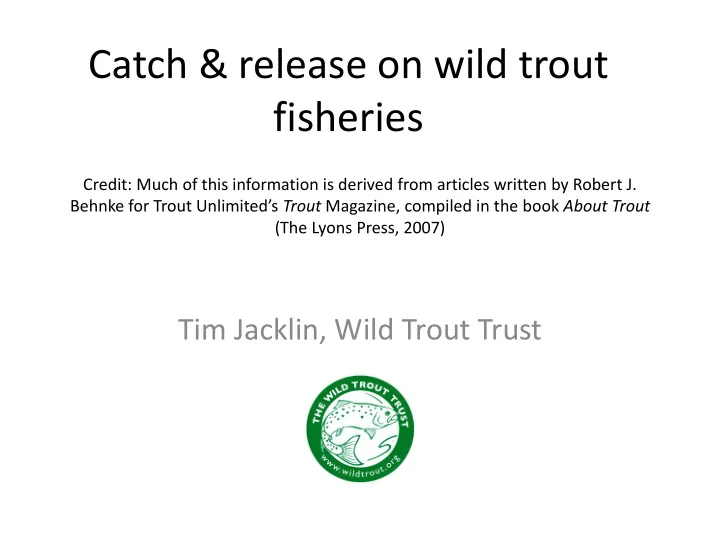

Catch & release on wild trout fisheries Credit: Much of this information is derived from articles written by Robert J. Behnke for Trout Unlimited’s Trout Magazine, compiled in the book About Trout (The Lyons Press, 2007) Tim Jacklin, Wild Trout Trust
Catch & release - does it make a difference? • It depends! • Two important factors: ➢ The biology of the trout population – recruitment, production, growth and survival rates ➢ Vulnerability of the trout population – how easy are they to catch and re-catch?
Biology – example 1 • Brook trout in Michigan & Wisconsin (1950s and 60s) • No effect of catch & release on total annual mortality rates • Typical e.g. Lawrence Creek, WI. One mile, angling closed 5 years = fewer fish than when open to angling. • Why?
Biology – example 1 • Brook trout mortality rate patterns Age Mortality rate Egg to age 0 (end of Very high (95%+) first growing season) Age 0 to 1 (over first 50 - 60% winter) Age 1+ first 80 – 95% spawning (in second autumn of life) Age 2 - 3 95 – 98% • i.e. in fish populations that live fast and die young, catch and release doesn’t make a lot of difference
Biology – example 2 • Cutthroat trout, Yellowstone Lake (88,000 acres) • Cutthroats very vulnerable to capture, even at low angling levels • Up to 1970, bag limit 3 trout of any size. • 1970 – 73, bag limit two trout of more than 14 ins. • Still a big decline in the population
Biology – example 2 • 1975 All fish over 13 ins must be released , 2-fish bag limit, fly/artificial lure only. • Very successful: Before 1975 regulation After Pelican Creek spawning run 1960s – 12,000 1980s – 24,000 Clear Creek spawning run 1950s - <10,000 1978 – 70,000 Trophy fish (>18 ins) 1973 – 3 per 1000 1983 – 80 per 1000 1974 – 5 per 1000 Proportion of repeat Pre-regs – a few % Post-regs – 25 to 30% spawners
Biology – example 2 • Similar results on Yellowstone River • 1973 introduced no-kill , fly & lure only • 1974-75 total catch was 2.5 times the catch in 1970-72 • Catch per hour tripled • Average fish age and size increased • In 1981 study estimated 7500 trout provided a catch of 72,698 captures in 6 weeks. • Each trout caught and released average of 9.7 times • Mortality in this period 0.3%
Biology – example 2 • Why were restrictions on killing fish so successful in Yellowstone? • The fish are relatively long- lived (5 – 8 years) • They grow well throughout their life (around 3 inches p.a.) • They are very vulnerable to capture and re-capture (10- 12 hours angling/acre/year to catch each fish once)
Mortality Rate (Natural + Angling) Comparison 1200 1000 1000 1000 800 x 2 x 4 x 8 x 16 Fish Numbers 600 50% Mortality 500 75% mortality 400 250 250 200 125 63 63 16 4 0 2+ 3+ 4+ 5+ 6+ Fish Age Bigger Fish ----->
Is this applicable on the waters we fish? • Fish certainly fit the biological requirements: long-lived, good growth... • ...but brown trout not as vulnerable to capture as cutthroats and brook trout • Culture of “take - able” fish above about 12” – these are the ones we should be returning! • I think it does apply to our rivers….
21-inch (about 3¼ lb) wild brown trout from upper Dove, June 2010 Re-captured May 2011. Also know it was caught by other members: once in 2009 and once in 2010.
A 60-cm Laxa fish – an 80-cm fish of the future?
Recommend
More recommend